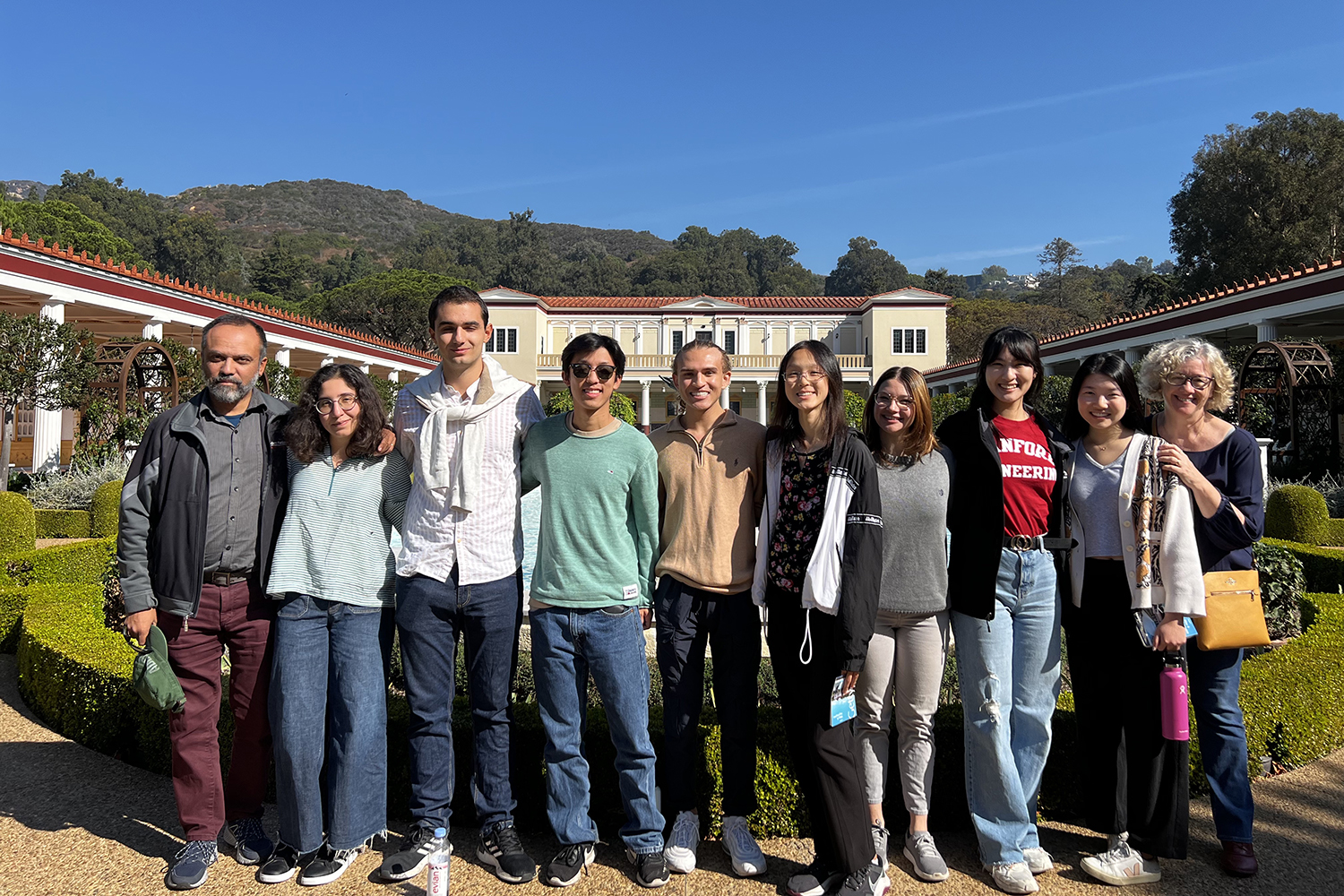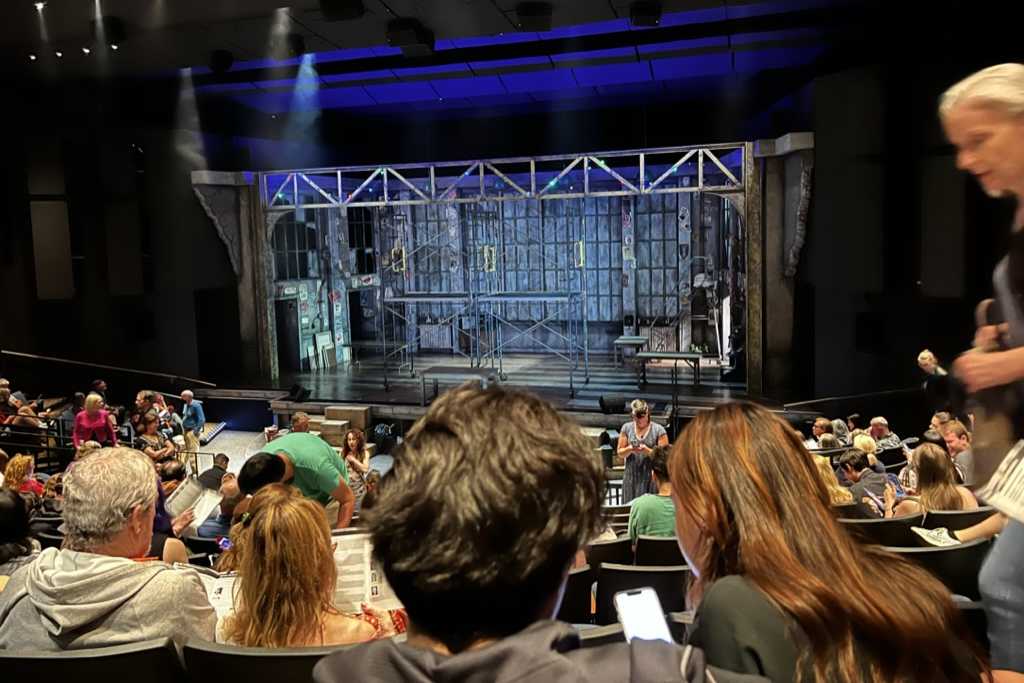Taking learning beyond the lecture
VPUE’s Academic-Residential Co-Curriculum program gives students and faculty the opportunity to connect outside of the classroom and create lasting professional networks.

Professors Grant Parker (far left) and Elaine Treharne (far right) with students on a recent trip to the Getty Villa Museum in Los Angeles. (Image credit: Elaine Treharne)
To Elaine Treharne, professor of English in the School of Humanities and Sciences and senior associate vice provost for undergraduate education, some of the best moments of teaching are the little ones. One-on-one conversations on a post-lecture walk through the Quad, a student stopping by her office to ask a question or dive deeper into material.
It’s these moments, the opportunity to connect outside of the classroom, that form the basis of Stanford’s Academic-Residential Co-Curriculum program. ARC, which launched last year under the Vice Provost for Undergraduate Education, aims to enhance undergraduates’ opportunities to connect with and form lasting professional networks with professors who can develop into lifelong mentors.
“It’s really important to be able to help students build good mentorship opportunities particularly with academic staff and faculty, in order to learn about the fullness of academic life,” Treharne said. “It’s about taking things that are really interesting in the lecture theater into a sort of small group conversation or considering it in relation to our local area, the campus, or more broadly.”
Moving outside the classroom
For some students, the classroom, with one faculty member at a podium facing a lecture hall of hundreds, can be an intimidating place to ask a question or share a thought. Enter ARC.
Led by faculty members across disciplines and supported through ARC and Nexus departmental grants, ARC fellows host activities aimed at augmenting the classroom experience. So far this academic year, students have participated in events ranging from the Oregon Shakespeare Festival in Ashland, Oregon, to a panel with the Distinguished Careers Institute and small group coffee hours.
While participating in these events, students and faculty alike engage with learning and materials in a new way.
“Some of the best conversations we had [at the Shakespeare Festival] were with students at breakfast or while we were waiting to go into the theater,” Treharne said. “In other words, while we were standing in close proximity and there isn’t any pressure, because you know you’re all there for the same reason, to talk about Shakespeare.”

Students in the ARC program attended the Shakespeare Festival in Ashland, Oregon, last year, a trip that provided opportunities for them to learn from and connect with faculty outside the classroom. (Image credit: Elaine Treharne)
The result is a space for accessible yet intellectual and academic conversations and the development of informal advising. And in some cases, the nurturing of students’ confidence, positivity and sense of belonging.
“It’s a well-funded, coherent effort on the part of the institution and its faculty and academic staff to find ways to enhance a student’s undergraduate experience,” Treharne said.
Stanford senior exit surveys and other surveys conducted by VPUE suggest that about a third of students report leaving the university not having connected professionally with a faculty member. And while the university supports students in finding and participating in extracurricular activities, Treharne said it’s just as important for faculty to consider their role in creating a campus culture of mentorship rooted in academic-residential curriculum.
Choose your own adventure
To encourage faculty participation and diversify the offerings provided through the program, ARC is designed to be flexible and meet the needs of both students and professors participating.
For Grant Parker, associate professor of classics in H&S, this included a recent trip to the Rosicrucian Museum in San Jose, which houses the largest collection of Egyptian antiquities west of Chicago.
At the event, Parker’s students explored the museum’s many exhibits. He asked them to consider why Egypt has seemingly fascinated outsiders for so long, and why people a century ago in suburban San Jose may have decided to recreate an ancient Egyptian temple.
“I asked ‘Why should anyone care about this stuff? Especially when we’re talking about something so far away in time,’” Parker said.
But as he watched his students wander through the artifacts and the museum’s gardens, he noticed something else.
“I can sense when students are having fun, and they were having fun,” Parker said. “Too often, I hear students talking about work hard, play hard, but what about the simple thrill of discovering something new? This program can help facilitate something like that.”
It’s a feeling Parker, who has served more than 13 years as a Resident Fellow at Toyon Hall, recalls fondly from his own time as a student.
“I suppose I’ve become more and more focused on intellectual curiosity as a thing in and of itself,” Parker said. “And it’s clear that with a small group of students, you can promote that directly and have a very different kind of interaction than you would have in a large classroom.”
In the coming months, Treharne, Parker, and the many other colleagues who make up the ARC program and advisory board will be bringing students together through more panels with the Distinguished Careers Institute, small field trips with faculty to places like San Francisco and TomKat Ranch, and a reading weekend in the spring quarter.
They hope their work this year can inspire other faculty members to generate ARC ideas that support learning outside the classroom, and Treharne urges colleagues to send ideas for activities, events, and mixers.
“Our residential campus gives us a golden opportunity to offer a holistic learning experience for Stanford students,” said Treharne. “The ARC initiative will make a transformational difference to students’ lives and futures and we’re looking forward to working with faculty to shape this initiative.”
Faculty interested in learning more about ARC and applying for an ARC or Nexus Departmental Grant can find out more on the VPUE website.